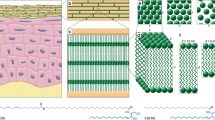Abstract
Alpha-hydroxy acids (AHA) such as glycolic acid have recently been used extensively in cosmetic and dermatological formulas. In low concentration (2– 5%) glycolic acid is believed to facilitate progressive weakening of cohesion of the intercellular material of the stratum corneum (SC), resulting in uniform exfoliation of its outermost layers (the stratum disjunctum). Since thinning of the SC as well as changes of intercellular lipids could theoretically compromise the barrier functions of the skin, we investigated the mode of AHA action on the SC to determine whether enhanced desquamation compromises the barrier structures of the SC and changes transepidermal water loss (TEWL) values. Electron microscopy of the epidermis biopsied from the volar forearm of human volunteers after 3 weeks of treatment with a 4% glycolic acid formulation twice daily was employed to evaluate 1) epidermal morphology and thickness of the SC, (2) the lamellar body and SC lipid bilayer organization, and (3) desquamative events based on degradation of desmosomes. TEWL values and SC hydration were recorded prior to and at the end of the study. Electron microscopy revealed no ultrastructural changes in the nucleated layers of the epidermis. The lamellar body (LB) secretory system in the stratum granulosum (SG), and intercellular lipid lamellae in the SC in both vehicle- and glycolic acid-treated samples were comparable to normal human SC. Within the SC, enhanced desmosomal breakdown, promoting loss of cohesion and desquamation, was restricted to the stratum disjunctum while desmosomes of the stratum compactum were unaffected. Treated areas displayed histologically, a more compact appearing SC. TEWL values remained unchanged in glycolic acid- and vehicle-treated skin. Our findings indicate that the barrier structures of the SC are not disrupted by glycolic acid formulations at the concentration used. One of the mechanism of action of AHA on the SC seemed to be a „targeted“ desmosomal (corneosomal) action without compromising the barrier structures of the skin.
Similar content being viewed by others
Author information
Authors and Affiliations
Additional information
Received: 20 November 1996
Rights and permissions
About this article
Cite this article
Fartasch, M., Teal, J. & Menon, G. Mode of action of glycolic acid on human stratum corneum: ultrastructural and functional evaluation of the epidermal barrier. Arch Dermatol Res 289, 404–409 (1997). https://doi.org/10.1007/s004030050212
Issue Date:
DOI: https://doi.org/10.1007/s004030050212




